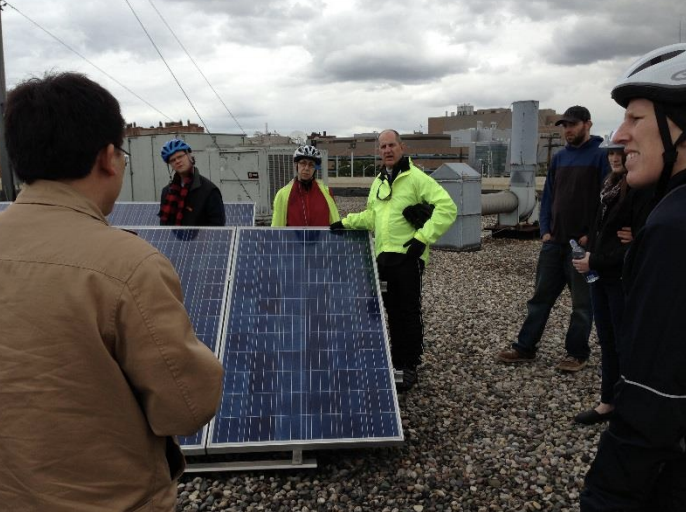Research
Wayne State University, as a certified research university, has a whole host of opportunities to delve into sustainable research.
If you are a student looking for independent research funding, visit the Undergraduate Research Opportunities Program (UROP) website for more information on research awards and grants!
If you are interested in researching how water in urban settings can impact public health and urban ecosystems, visit Healthy Urban Waters!
Current and past research projects
WSU wind turbine
If you've been at the intersection of Anthony Wayne Drive and Warren Avenue, you have probably seen Wayne State's wind turbine. This research effort by Caisheng Wang, associate professor of engineering technology, has drawn lots of attention. As part of a renewable energy system, a 5kW vertical wind turbine stands on the roof of the Engineering Technology Building. Just as a hydroelectric dam captures the kinetic energy of moving water, wind turbines capture the kinetic energy in wind.
How does it work?
The blades of the turbine are designed to rotate when pushed by wind. When the blades start moving they spin a shaft which leads to a generator. The rotor transfers rotational energy to the shaft, and the generator turns the rotational energy into electricity. A generator consists of a conductor (usually coiled wire) surrounded by magnets. The shaft of the wind turbine rotates the magnets relative to the conductor, thus generating voltage in the wire. Voltage moves electric current, so when voltage is generated, essentially so is current. This current is the electric power produced by the wind turbine.
WSU solar array
In addition to the wind turbine, a 4kW solar panel is also part of the renewable energy system. Most people have either seen or heard about solar panels but wonder how these plates of glass capture energy. Here's a brief description of how the technology works.
Solar panels are made up of groups of photovoltaic (PV) cells, which are made of semiconductors (usually silicon). The semiconductor material absorbs light shining on the PV cells. The energy of the absorbed light is transferred to the semiconductor, knocking electrons loose so they can flow freely. PV cells also have electric fields that point the free-flowing electrons in a certain direction and generate voltage. This flow of electrons is a current which can be collected with metal contacts on the top and bottom of the PV cell. The current from the electron flow and the voltage from the electric field produces the power of the solar cell.
If the utility power goes out, does that affect this system?
 Combined, the 5kW wind turbine and the 4kW solar panel create a hybrid renewable energy system. The system charges a 48kWh battery pack inside the Engineering Technology Building. A 7.2 kW inverter converts the direct current (DC) electricity from the battery pack into 60 Hz alternating current (AC) electricity. This powers a computer lab in the building and can be switched to a lab in the Industrial and Manufacturing Engineering building. The hybrid system takes the grid power as a backup, making it one of the most reliable systems on campus. The computer lab normally runs on the renewable system but switches to the grid if there is a problem. This lab is therefore the only location in the engineering buildings with reliable power during power outages.
Combined, the 5kW wind turbine and the 4kW solar panel create a hybrid renewable energy system. The system charges a 48kWh battery pack inside the Engineering Technology Building. A 7.2 kW inverter converts the direct current (DC) electricity from the battery pack into 60 Hz alternating current (AC) electricity. This powers a computer lab in the building and can be switched to a lab in the Industrial and Manufacturing Engineering building. The hybrid system takes the grid power as a backup, making it one of the most reliable systems on campus. The computer lab normally runs on the renewable system but switches to the grid if there is a problem. This lab is therefore the only location in the engineering buildings with reliable power during power outages.